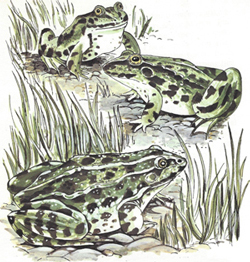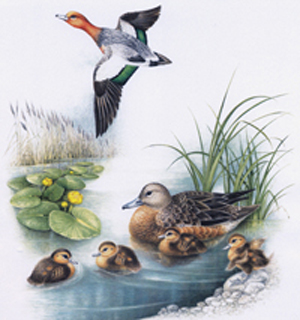tipho-, tiph-, tiphi-, -tiph
(Greek: standing water, pool, pond, marsh, swamp)
Etymology from Composition of Scientific Words by Roland W. Brown; Smithsonian Institutions Press; Washington, D.C.; in "marsh" group; 1985; page 514.
ombrotiphic (ahm" broh TIF ik) (adjective), more ombrotiphic, most ombrotiphic
A reference to temporary pools of water that have formed from melting snow or rain: Max's little boy loves to jump into the ombrotiphic puddles in the backyard before they evaporate into the air or sink into the ground.
Plants that grow in ponds or marshes: In addition to numerous grasses, tiphads include cattails and sedges all of which have dense root systems that trap silt and debris.
tiphic (TIF ik) (adjective), more tiphic, most tiphic
Referring to ponds and communities of various creatures that are dwelling in them: Some of the tiphic animals include mallards and teal (a small water bird similar to a duck) which usually feed at the surface of the water by snapping at floating food and even from the bottom in shallow water by tipping their beaks down and paddling vigorously with their feet.
tiphicoline (TIF i koh" line) (adjective), more tiphicoline, most tiphicoline
Relating to wetland plants that exist in shallow water: Some of the most tiphicoline vegetation are grasses that support a variety of organisms.
tiphicolous (TIF i koh" luhs) (adjective), more tiphicolous, most tiphicolous
Pertaining to rooted and emergent foliage and creatures: The tiphicolous plants include cattails (tall erect herbs with sword-shaped leaves) and burreeds (plants that bear burs) that live in ponds or shallow water areas and the tiphicolous animals that include frogs and their tadpoles, turtles, worms, crayfish, and other crustaceans, insect larvae, and many fish; such as, perch, carp, and bass.
A pond or pool where groups of animals live: A tiphium usually has the greatest number of activities in spring because this is when large frogs and spring peepers (small brown tree toads) are having shrill calls because these amphibians are mating and laying their eggs.


Examples of frogs that live in various areas of tiphia.
Wetland vegetation which provides food to support a significant number of organisms: The tiphophiles are wildlife habitats for migratory waterfowl and many other bird species, beavers, otters, muskrats, and game fishes.


These ducks represent a few tiphophiles that are living in marshes, ponds, or swamps.
tiphophilic (TIF uh fil" ik) (adjective), more tiphophilic, most tiphophilic
Characteristic of marshes and swamps that are havens for wildlife: Some tiphophilic snails feed on the great supply of decaying plant material in the wild wetlands and then there are larger animals which seem to be attracted to the quiet wetland because they provide resting places for a significant number of waterfowl.
tiphophilous (TIF ah fil" uhs) (adjective), more tiphophilous, most tiphophilous
Descriptive of still waters of marshes and swamps: Most tiphophilous plants have extremely dense root systems, which trap silt and debris.

Although the wetlands seem uninviting to human visitors, they are more tiphophilous havens for wildlife; including, reptiles, turtles, snakes, alligators, and waterfowl.

Some tiphophilous waterfowl in a marsh.
Places where aquatic and land animals like to live: The tiphophily of the areas in tracts of low and stagnant waters are habitats where different species intermingle or share the quiet wetlands together.
Plants that grow in a pond, a pool, a wetland, or some area that is saturated with water: The tiphophytes in a marsh are primarily composed of grass while those in swamps usually consist of trees.
Information for this tiphos unit were compiled from presentations in the following sources:
- The Cambridge Illustrated Dictionary of NATURAL HISTORY, by R. J. Lincoln and G. A. Boxshall; Cambridge University Press; Cambridge, England; 1990; page 383.
- Biology, Sixth Edition; Brooks/Cole, Thomson Learning; Printed in the U.S.A; 2002; page 1221.
- Reader's Digest, Joy of Nature; The Reader's Digest Association, Inc.; Pleasantville, New York; 1977; page 182.
- The Dictionary of the Biological Sciences by Peter Gray; Reinhold Publishing Corporation; New York; 1967; page 534.
<img src="/img/left_arrow_sm.gif" alt="" /> <img src="/img/right_arrow_sm.gif" alt="" />
Showing 1 page of 11 main-word entries or main-word-entry groups.
